Viet Nam–US relations: The 25-year journey

President of the United States of America Bill Clinton and Prime Minister of the Socialist Republic of Vietnam Vo Van Kiet officially announced the normalization of relations and establishment of formal diplomatic ties between Vietnam and the United States.
A quarter of a century has passed since President of the United States of America Bill Clinton and Prime Minister of the Socialist Republic of Viet Nam Vo Van Kiet officially announced the normalization of relations and establishment of formal diplomatic ties between Viet Nam and the United States (July 12, 1995–July 12, 2020). Having surpassed initial hesitations, through the tireless efforts from both countries and nations, Viet Nam and the United States have become friends, and Comprehensive Partners in all areas, with broad prospects for cooperation in the future.
The 25th anniversary of this historic milestone in the Viet Nam-U.S. relations is an opportunity for the two sides to look back upon the journey already traveled, evaluate the present and look towards the future and, together, cultivate a relationship commensurate with the existing potentials and that will live up to the interest and aspiration of both countries and nations.
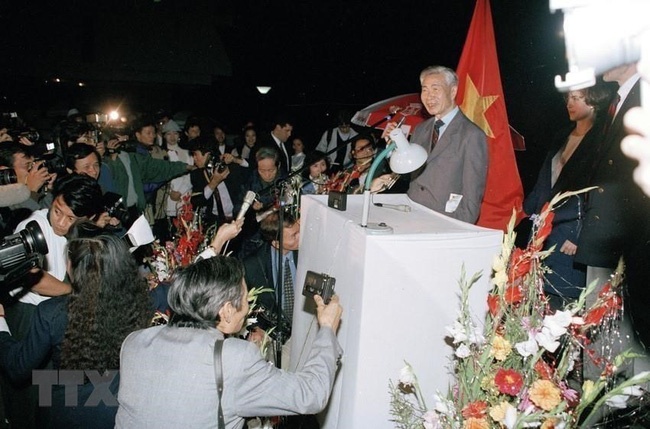
Former Foreign Minister Nguyen Co Thach spoke to journalists on February 4, 1994, at an event held in Ha Noi on the US's abolition of the trade embargo with Viet Nam. (Photo: VNA)
Fostering trust as the foundation of the relationship
Trust is ever the bedrock of all relationships: be they among individuals, groups, states or nations. Trust is built, nurtured and cultivated through concrete deeds that stem from goodwill and good faith. The reality of the relationship between Viet Nam and the United States illustrates this very fact. Between two countries that are former enemies, trust is an even more important factor. Indeed, the first trust-building blocks between the two countries were laid through cooperation to address war legacy issues.
Following the 1973 Paris Peace Accords, Viet Nam took the initiative in organizing its own teams, which discovered, excavated and returned to the United States the remains of more than 300 American servicemen. Thousands of Vietnamese folks, though the bones of their own children and kin lost in the war had yet to be found, nevertheless joined in the voluntary effort to search for the remains of those on the other side. It is these enormous efforts from the Vietnamese government, the spirit of peace and kindness, and the willingness of the Vietnamese people to set aside the past, which has led to a profound change in the prevailing U.S. domestic perception on healing the wounds of the war. To date, the two countries have repatriated the remains of more than 1000 American servicemen, among which more than eight hundred MIA cases have been identified.
On its part, the United States has provided information and documents related to Vietnamese soldiers martyred in the war and assisted Viet Nam in finding and interring the remains of nearly 1,500 martyrs into war cemeteries. The U.S. Government has been increasing the budget for activities on addressing war legacy issues. The Environmental Remediation of Dioxin Contamination at Da Nang Airport Project was completed in 2018, and Dioxin Remediation at Bien Hoa Airbase Area Project is being initiated. The U.S. Government also provided more than $125 million for the healthcare of 1 million Vietnamese persons with disabilities and donated $130 million to other projects for UXO removal. Viet Nam acknowledges the efforts of the United States in performing its moral responsibility of addressing the war legacy issues.
Additionally, people-to-people diplomacy and educational cooperation have also been instrumental in fostering the mutual trust between the two countries, especially during the very first months and years of the normalization process. Ho Chi Minh City and San Francisco (California) signed a Sister City agreement three months before the official establishment of diplomatic ties. In the same way, educational cooperation between Viet Nam and the United States, most strikingly the Fulbright program which was commenced in 1992, has provided support for more than 500 U.S. citizens and nearly 700 Vietnamese in their learning, scholarship and teaching endeavors. Trust, so cultivated and reinforced, has created a critical foundation for the reconciliation between the two countries, leading up to the normalization and establishment of diplomatic relations on July 12, 1995.
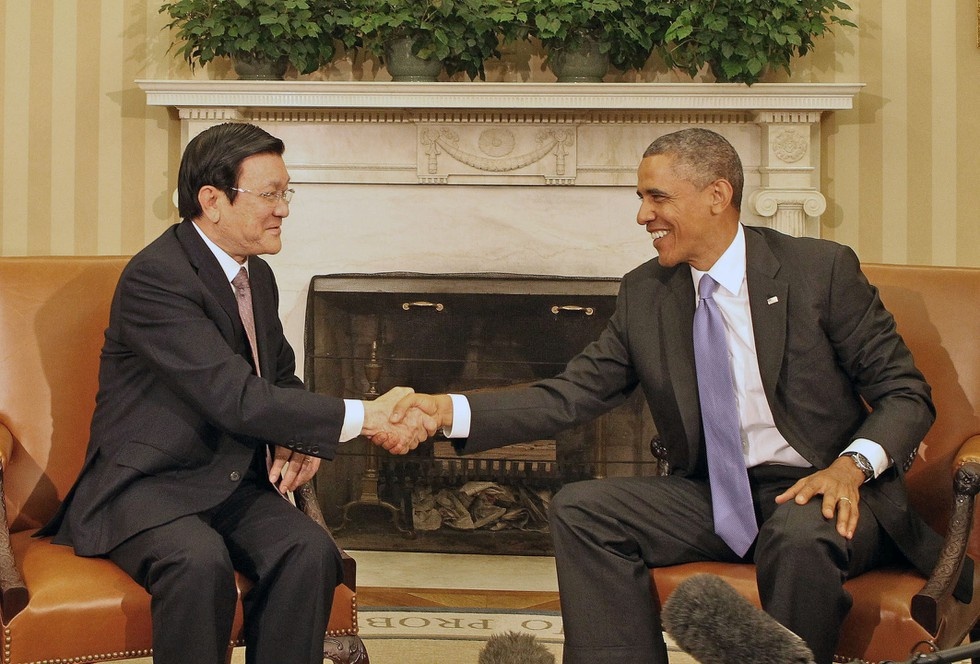
Vietnamese President Truong Tan Sang and his US counterpart Barack Obama during their historic visit in July 2013 when the two sides announced that they would establish a comprehensive partnership. (Photo: VNA)
Setting aside the past, looking towards the future
Viet Nam seeks to “set aside the past, look towards the future” and work with the U.S. to build a partnership on the principle of mutually beneficial cooperation, equality, respect for each other's political system, independence, sovereignty and territorial integrity. This is a consistent direction of the policy line of the Vietnamese Party and State, and well in line with the spirit of harmony, kindness and the traditional love for peace of the Vietnamese nation. The tireless efforts from the two states, and especially the two peoples, have seen the relations between Vietnam and the United States grow in both breadth and depth across all areas and levels, in the true spirit of the Comprehensive Partnership.
Political and diplomatic ties are growing steadily. The exchange of high-level delegations has been taking place frequently and continually. Since 2000, the high-level leaders of the two countries have paid ten mutual visits. Most notable among these were the visit to the United States by the President of Viet Nam Truong Tan Sang in 2013, during which both countries established the Comprehensive Partnership, the visit by General Secretary Nguyen Phu Trong in 2015, which was the first-ever official visit of the supreme leader of the Communist Party of Viet Nam to the United States, and the visit in 2017 by Prime Minister Nguyen Xuan Phuc, who was the first ASEAN leader to pay a visit to the United States after President Donald Trump took office. From the United States, every recent incumbent US President has paid a visit to Viet Nam. President Trump, in particular, has twice visited Viet Nam in 2017 and 2019, respectively. Each visit of the leaders from either side left its own hallmark and set new milestones for the bilateral relations.
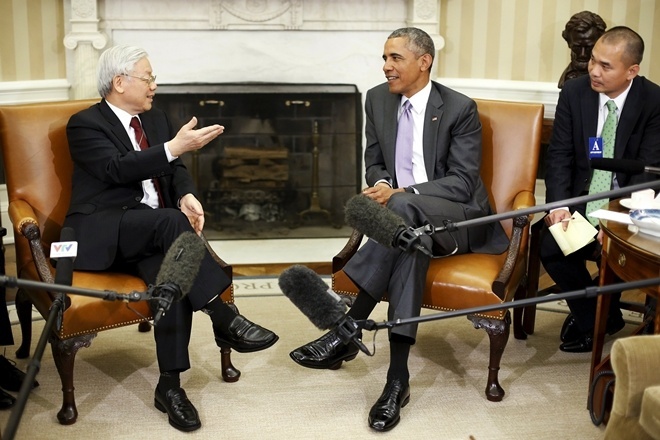
General Secretary Nguyen Phu Trong and US President Barack Obama at the White House, July 2015. (Photo: Reuters)
To elaborate, during these visits, the two sides adopted eight joint statements in total. Most noteworthy is the 2013 Joint Statement, which defined the framework for the Comprehensive Partnership between Viet Nam and the United States with nine key areas of cooperation, and for the first time, identified the principles of mutually beneficial cooperation, equality, and respect for each other’s political system, independence, sovereignty, and territorial integrity. The 2015 Joint Statement set a common vision for the bilateral relations, stressing the importance of deepening a long-term partnership and increasing cooperation on regional and international affairs. The 2017 Joint Statement further set a roadmap for further deepening the relations between the two countries.
In addition, the stately reception the United States accorded to General Secretary Nguyen Phu Trong in 2015 was a demonstration of their “full respect” for the political system of Viet Nam and for the all-rounded leadership of the country by the Communist Party of Viet Nam. The U.S. Government and Congress have, on multiple occasions, reaffirmed the importance of strengthening the Comprehensive Partnership with Viet Nam and their support for a “strong, prosperous and independent” Viet Nam, and recognized Viet Nam's significant role in the U.S. policy in the region.
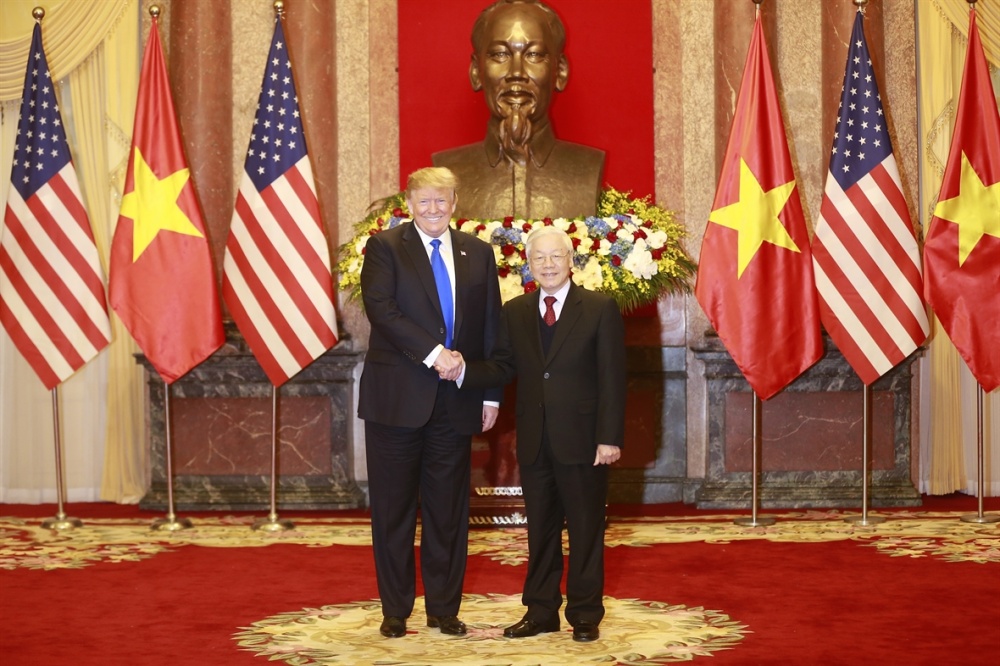
General Secretary and State President Nguyen Phu Trong received US President Donald Trump on February 27, 2019.
A comprehensive and substantive relationship
An essential and indispensable component of the ties between Viet Nam and the United States, which is enjoying the most robust and impressive growth, is economic, trade and investment cooperation. Starting at $450 million in 1995, the bilateral trade turnover has increased by 170 times to $76 billion in 2019. The economies of Viet Nam and the United States have become increasingly complementary. The United States continues to be Viet Nam’s largest export market, involving various key Vietnamese exports such as seafood, textiles, footwear, and agricultural produce. Conversely, Viet Nam is also one of the fastest-growing export markets of the United States, as Vietnamese consumers have become increasingly fond of “Made in USA” products from agricultural produce to telecommunications, aviation, financial and banking services, and education.
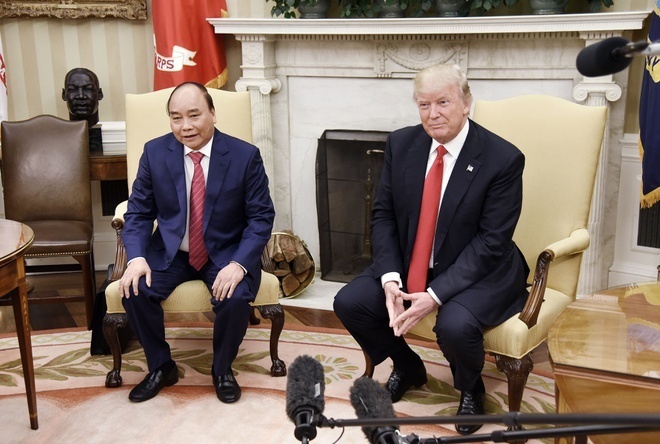
Prime Minister Nguyen Xuan Phuc is the first leader of an ASEAN country to visit Washington after President Donald Trump takes office.
Regarding investment, the United States is the 11th largest foreign investor in Viet Nam with investments in diverse formats in 43 out of 63 Vietnamese cities and provinces. Many large American corporations have been operating effectively for many years, and are making plans to expand their footprints in Viet Nam, thus helping Viet Nam to gradually secure its position in the regional and global supply chains.
Cooperation in science and technology is growing strong and expanding into many new fields. Various U.S. tech giants are looking forward to stronger cooperation in areas of special interest to both countries, such as AI, innovative startup, renewables, IT infrastructure, and training of a high-quality workforce. Following the establishment of diplomatic relations, cooperation in education and training grew by leaps and bounds. Starting at only about 500 in 1995, the number of Vietnamese students in the United States has now exceeded 30,000, making Viet Nam number 1 in ASEAN in terms of students in the United States. Furthermore, Vietnamese students also have the opportunity to do studies and research at the Fulbright University Viet Nam.
Tourism is another highlight in the bilateral relations. The number of U.S. tourists to Viet Nam increases steadily on an annual basis. The U.S. Travel Association has voted Viet Nam one of the 10 most attractive destinations in the world in 2019. To U.S. visitors, Viet Nam is becoming a safe and friendly destination and a good venue for major international events.
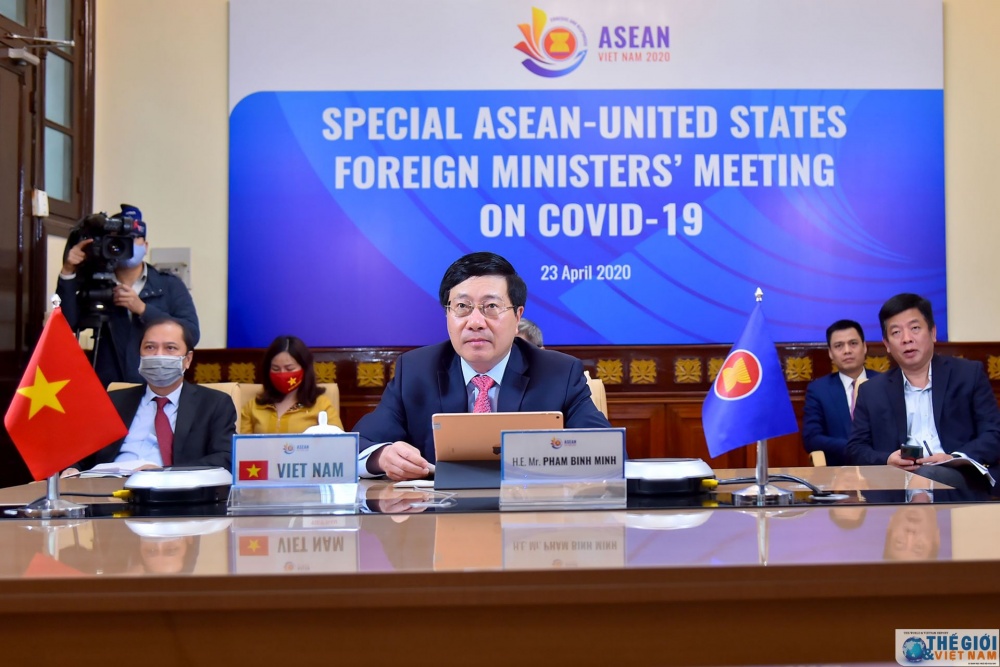
Deputy Prime Minister and Foreign Minister Pham Binh Minh attended the ASEAN-US online meeting on COVID-19, April 23, in Ha Noi.
The scope of Viet Nam – U.S. cooperation is not only limited to bilateral matters but has been expanding to regional and global issues. This reality is consistent with Viet Nam's policy of active and proactive international integration and being a responsible member of the international community, and is in line with the interests and trajectory of the bilateral ties. The two countries have worked in closer coordination at international and regional forums, such as the United Nations, APEC, ARF, EAS, and many others. This close coordination has also been seen in addressing a range of issues: WMD non-proliferation, combating transnational crimes, and UN peacekeeping operations, the sustainable development of the Mekong sub-region, and promotion of the ASEAN-U.S. Strategic Partnership.
The two sides are also strengthening cooperation in championing the freedom, safety and security of navigation and overflight in the region, promoting the peaceful settlement of disputes on the basis of international law, including the 1982 UNCLOS. This is particularly relevant during the year Viet Nam assumes a non-permanent membership of the UN Security Council and the ASEAN Chairmanship. This has practically contributed to peace, cooperation and development in the region and the world.
Overcoming differences, penning a new future
As are all bilateral ties in the world, Viet Nam and the United States are faced with our share of differences and disagreements. This is understandable for two countries of distinct cultural and historical backgrounds, political systems, and development levels, seeking to further deepen their growing comprehensive partnership.
Yet above all, both countries have shown respect for each other’s political system, independence, sovereignty and territorial integrity. Both sides have been making an effort to foster dialogue, promote cooperation and minimize differences that may affect the overall relations. At the same time, dialogue mechanisms have been sustained to resolve disagreements in a frank, open and constructive manner.
At present, the two countries are actively reviewing outstanding issues and addressing a number of the U.S. concerns, which include effectively implementing the Action Plan towards a harmonious and sustainable trade balance in order to alleviate trade deficit. Both sides also continued dialogues to bridge differences on human rights, democracy and religion.

Deputy Prime Minister and Foreign Minister Pham Binh Minh held a meeting with US Secretary of State Mike Pompeo on May 22, 2019.
After 25 years of normalization of relations and 7 years of Comprehensive Partnership, the achievements of the two sides speak well for themselves. It is clear that Viet Nam and the United States have made the right decisions to cooperate on the basis of equality, mutual benefit, respect for each other’s independence, sovereignty, territorial integrity and political system, and in adherence to the UN Charter and fundamental principles of international law. This has proven to be an inevitable trend and entirely in line with the interests of our peoples, and a testament to the resolution, efforts and strategic vision of our two countries’ leaders.
During his visit to the United States in 2015, General Secretary Nguyen Phu Trong said: “Though we were once enemies, we have become friends, partners, and now Comprehensive Partners. We cannot change the past. However, our future is in our hands”. Given all that has come to pass and all that is to come, Viet Nam and the United States may well take heart in the future. I should hope that the footsteps of the past twenty-five years shall inspire our youth to continue the ongoing journey of their forefathers and elevate our partnership to new heights in line with the interests of the two peoples, and thus practically contributing to peace, stability, cooperation and prosperity in the Asia – Pacific region and the world at large.
|
|
